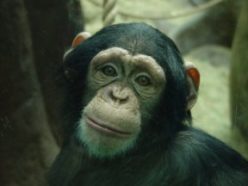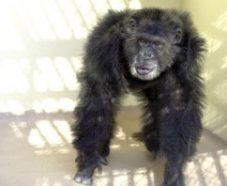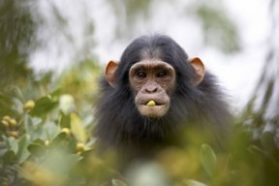From Chimps to People
Although chimpanzees and people share many genes, there are key biological differences.
By Emily Sohn
It can be fascinating to watch chimpanzees at the zoo. Chimps are the closest, living animal relatives to people. Watching them can be like watching ourselves.
 |
|
At 3 years old, chimpanzee Tammy is self-confident, bold, and smart. She lives at the Saint Louis Zoo and especially enjoys grapes, scrunchies, picture books, and blankets. |
| Photo by Carol Weerts, Saint Louis Zoo |
To figure out just how similar people and chimps are, scientists have been studying DNA—material in every cell that makes up genes and determines much of what we look like and who we are. Recently, an international group of researchers compared the entire genome (or set of DNA) of a male chimp to DNA data from people.
The results show that people and chimpanzees are indeed very similar, but we might be more different genetically than scientists previously thought.
DNA is made up of units called nucleotides. The sequence of nucleotides, also called base pairs, determines what genes do. The new study found that 3 billion of these base pairs have the same pattern in people and chimps 96 percent of the time.
That might sound like we have a lot in common. There are, however, as many as 3 million important base pairs that are different.
 |
|
Researchers studied the DNA and genes of a captive chimp named Clint. |
| Yerkes National Primate Research Center |
The scientists found six segments of DNA that seem to have changed a lot in people over the last 250,000 years. There was also a lot of variety at the ends of long stretches of DNA called chromosomes.
Other results show that chimpanzees have major mutations (nucleotide changes) on their Y chromosomes (which only males have), but human males don’t have the same mutations. And genes that are active in the brain have more mutations in people than in chimps.
 |
|
A young chimpanzee in Uganda’s Kibale National Park chews a fig. |
| Photo by Jean-Michel Krief |
Scientists don’t yet know what all of these differences mean. The more they learn, the more we’ll understand about the ancestors that we share with our ape cousins. Now, that’s something to think about the next time you eat a banana!—E. Sohn
Going Deeper:
Bower, Bruce. 2005. Chimps to people: Apes show contrasts in genetic makeup. Science News 168(Sept. 3):147. Available at http://www.sciencenews.org/articles/20050903/fob1.asp .
You can learn more about the chimpanzee genome at www.nature.com/nature/focus/chimpgenome/index.html (Nature).
Sohn, Emily. 2004. An inspiring home for apes. Science News for Kids (July 14). Available at http://www.sciencenewsforkids.org/articles/20040714/Feature1.asp .
Information for kids about DNA, genes, and heredity can be found at www.genetics.gsk.com/kids/index_kids.htm (GlaxoSmithKline).







